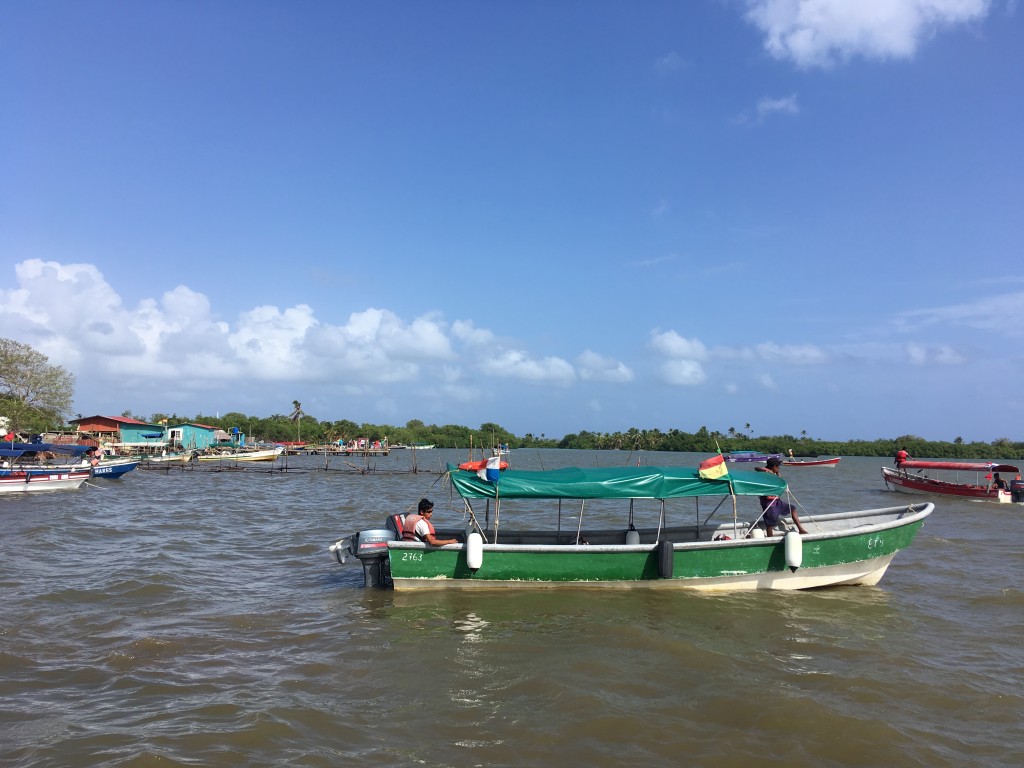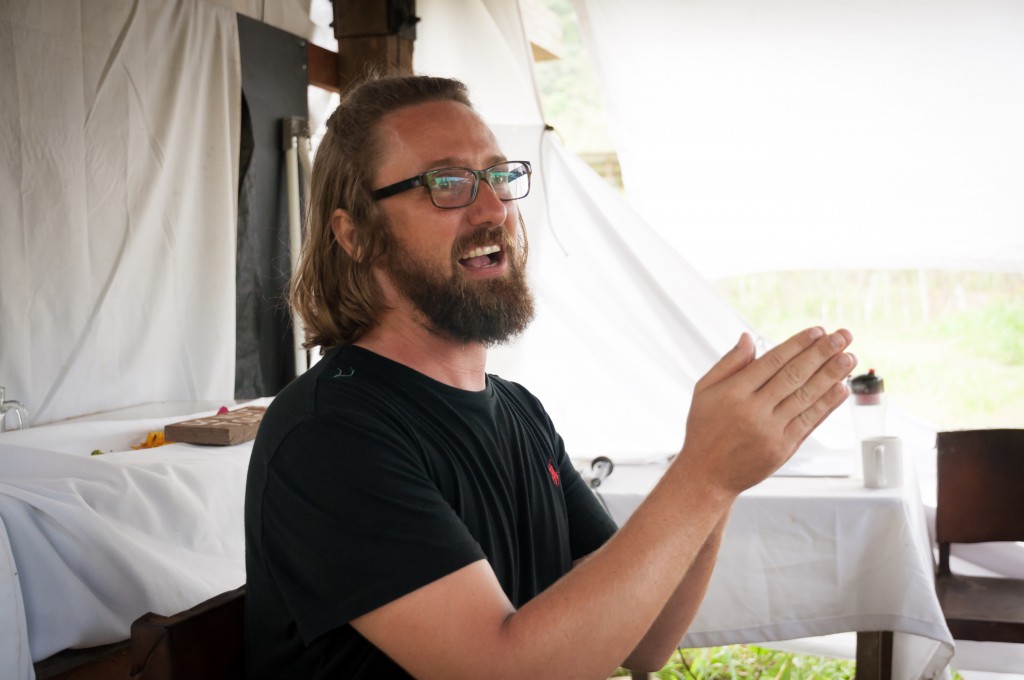
Traveling on boats is the main mode of transportation between islands of Guna Yala, and most are operated by local Guna people. (Luodan Rojas/Medill)

Traveling on boats is the main mode of transportation between islands of Guna Yala, and most are operated by local Guna people. (Luodan Rojas/Medill)
By Luodan Rojas
Separated by miles of ocean and a 2-hour drive, or a 50-mile hike, through the jungle, Guna Yala and Kalu Yala are two of Panama’s most sustainable communities.
Guna Yala, part of the San Blas Islands in the Caribbean, and Kalu Yala, a commune in the interior jungle, differ drastically in not only their locations, but also in contrasting heritages, culture, and history. What the two do share in common are beliefs and practices that revere the environment.
The Guna people, one of the country’s eight main indigenous groups live on the Guna Yala islands as an independent province off the coast of northeast Panama. More than 360 small islands make up the Guna archipelago, but only about 50 are actually inhabited and many of which welcome tourists.
The stark contrast between mainland Panama and Guna Yala is apparent even before setting foot on the islands. The water, astonishingly clear and filled with marine life, combined with white sands and palm trees make the perfect vacation spot. What is not immediately apparent, however, is the deeply rooted culture and traditions of the Guna people who consider the islands sacred.
According to Aresio Valiente López, a Guna environmental lawyer and professor fighting for indigenous rights, one distinguishing characteristic of Guna Yala is their right of self-government as an autonomous province.
A major component of the Guna culture is the unique relationship with their environment, which can be seen through much of the artworks and traditional clothing made by Guna people.
“Most of the Native American communities in the Americas are very, very close to the land and to the mountains and to the sea and to the environment in general. The Kuna people are not far from that,” said Diwigdi “Diwi” Valiente, a 28-year-old Guna environmental activist and entrepreneur.
While some aspects of Guna cultural beliefs regarding the environment may align with the Western concept of sustainability, they are not the same given their contrasting origins, usages, and connection to their respective cultures.
“There is supposed to be one prophet – similar to Jesus – that taught us how to behave like humans,” Valiente said, “We have this religion and way of thinking where we not only have the Mother Earth, but also the (Father) Sun.”
Delfino Davies, museum guide on the Guna Yala city island of Carti Sugtupu, explained that the dual aspect of mother and father is one of the most central aspects of Guna religion. Couplings are present everywhere in Guna life and culture; all places and objects are assigned either female or male.
Davies describes this coupling pattern that shows up distinctly in molas, the Guna’s traditional artwork sewed into a square of cloth, later made into clothing for Guna women. Molas typically have a geometric element to them and reflect designs from Guna legends and culture.
The Guna’s distinctive cultural beliefs are closely connected to their beliefs about climate change, or in some cases, lack thereof.
Valiente explains that many Guna do not have opinions about climate change, simply because they don’t have sufficient access to information on the topic. Many people in Guna Yala also don’t consider issues caused by climate change to be anything more than fluctuations in the weather, though they are seasonal witnesses to the increasing flooding linked to sea level rise as glaciers melt in polar regions.
“Here, in the islands: there are months when the islands get completely flooded. You have water up to your ankles. Imagine living for a month like that. There (are) people that still believe that’s because of nature itself,” Valiente said.
Abelardo “Tito” Nuñez Davies, 40, who resides on small Pelican Island island with his mother and nephews, notes matter-of-factly that his family’s Guna island is shrinking. The house, once in the center of the place, now flanks the sea. “What can I say? We’re here because of the grace of God.”
Nuñez also explains that although he and his family have had to temporarily relocate to nearby islands during big storms, they haven’t even thought about permanently moving.

Valiente sees climate change through a different lens as his people are disproportionately affected by it. “It’s super frustrating. It’s even worse because you try to explain (to) people climate change and they don’t understand it because they are not causing it,” he said.
“Panama doesn’t produce anything; we are a country of service. A country that did not contribute to climate change at all.”
Panama, as a developing country, does not hold much historical responsibility for the human-induced climate change present on the planet today given the country’s almost nonexistent role in industrialization. Panama is slowly becoming more developed but is still largely a country of service, with tourism as one of its biggest industries.
The tourism industry in Guna Yala has boomed so much in recent years to the point where it now contributes 80% of their income. This large percentage begs the question of how sustainable tourism can be in the long run.
Developing tourism options based on the mainland and seeking new directions for the economy are critical, said López, the Guna environmental lawyer. He explains that the Guna congress recently created a mixed enterprise in which people can buy shares for the first time. “Before, all the enterprises that the congress had were private, but now they created a transportation company that’s 60% owned by the institution and it’s 40% available… for sale for everyone.” Now the island residents will receive benefits from profits of all the boat traffic to the islands, he noted.
However, many Guna hold strong ties to their beliefs and are not easily subjected to change from outside influence.
“A lot of people tend to go and sort of pass judgment on them like ‘oh their towns are so dirty and stuff,’” says Panamanian architect Ricardo Arosemena. “But my response to that is: they could keep living exactly like that for a million years and they wouldn’t destroy anything and the way that we live — maybe you don’t see any garbage but we just destroy everything.”
“I mean, we have a culture that survived colonization from the Spaniards. We are much more than the Caribbean. And that’s something that we have not been able to explore and take advantage of as much as we could,” Valiente said.
Valiente is different from many other Guna. He works in mainland Panama with a primary focus in the sustainability industry and he also studied Hospitality Management and International Business Tourism at the César Ritz College in Switzerland.
Currently, Valiente works with Bodhi Hostels, a business whose mission is to “inspire and encourage sustainable ways of living and travel.” Valiente and his business partner, Allan Lim, recently opened up a new hostel location in Kalu Yala, a growing eco-city in the Panamanian jungle.
Keeping Kalu Yala’s mission in mind, Lim and Valiente incorporate sustainable practices into the creation and maintenance of their new hostel. In addition to using solar energy, “we try to apply all the cleaning practices that are organic: we use vinegar and water to clean,” Lim said. The partnership also hires only local Panamanians to work in their hostels.
In the words of the town’s CEO and creator, Jimmy Stice, Kalu Yala was founded with the intention to “build a new town that proves that civilization can live in a socially and environmentally responsible way.”

Kalu Yala’s mission is similar to the cultural beliefs of the Guna people, in that both are environmentally conscious and structured around a sense of community. The eco-city’s name actually has Guna origins, Kalu meaning “house of spirits, and Yala meaning “land” or “mountain.”
Although Kalu Yala is very modern and the Guna culture has been present for centuries, Valiente is a bridge between these two communities, being the first Guna person to work at Kalu Yala, but hopefully not the last.
Just like in the Guna islands, there are clear signs of tourism booming in Kalu Yala. In addition to the new Bodhi Hostel, there also are plans to build permanent residences in the eco-city.
“We’ll start introducing the small houses which will allow for people who want to sleep on a real mattress so $150 nights is also inclusive, just like $13 a night is inclusive,” Stice said.
In addition to the small houses, Kalu Yala plans to build larger Charleston-style homes and attract permanent residents as well.
“So I think we’ll be back up to 200 people by the end of next year,” with interns and staff, Stice said. With guests and hotel tourists, he anticipates a community of about 300. “And then we’ll actually introduce home sales in 2020 or 2021, and we’ll start adding maybe 50 full-time residents a year based on that.”
With all this new construction and development in Kalu Yala, it will be interesting to see how the community can still incorporate their sustainability values into these plans, and what they will do to potentially offset their emissions.